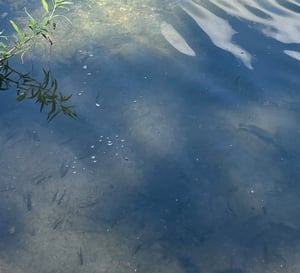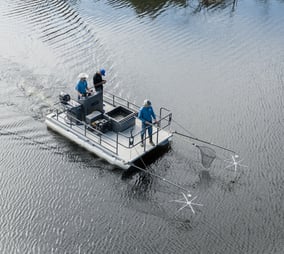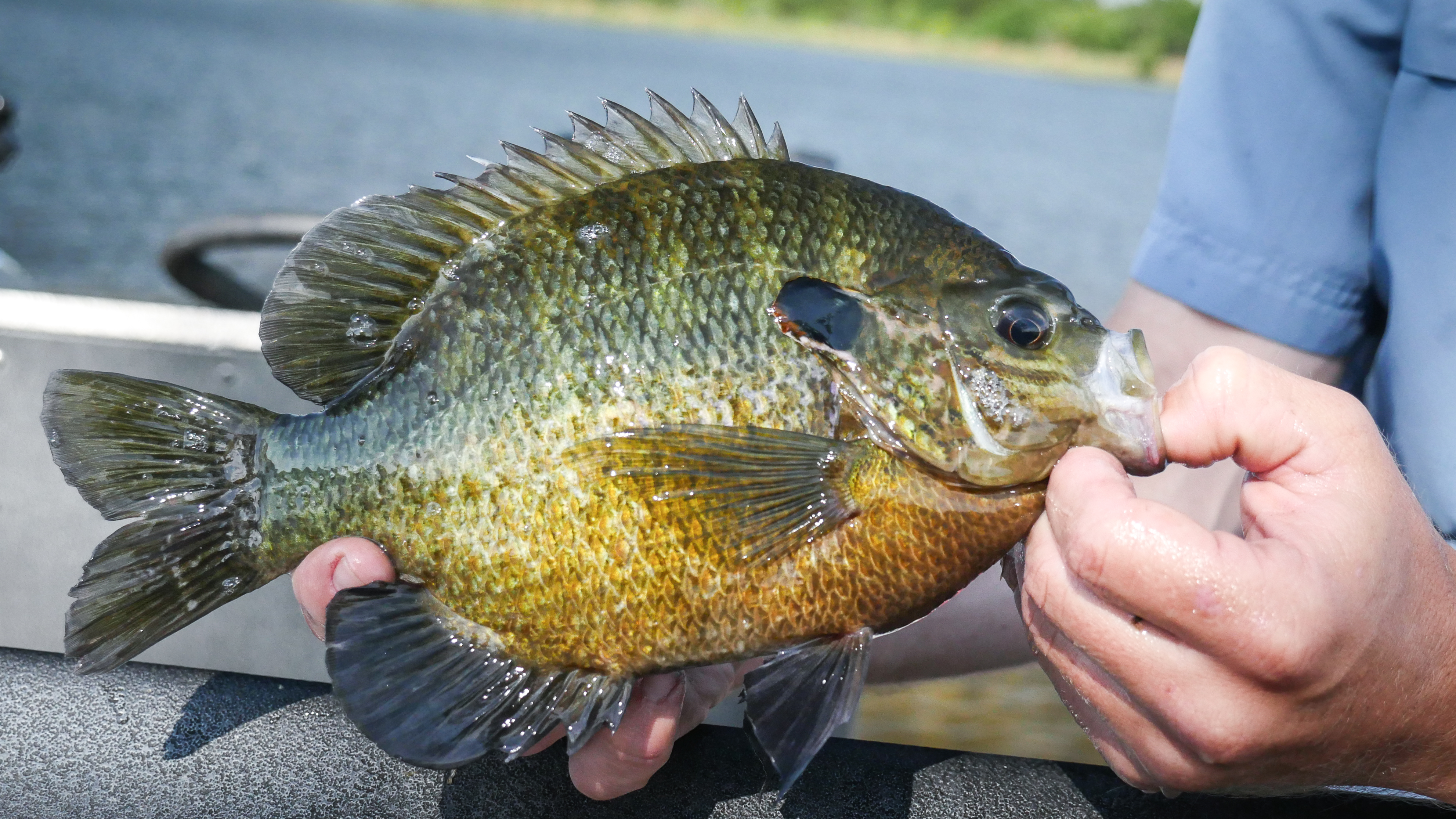If you are trying to establish a good broodstock of forage in your fishery, it is important to monitor the forage population because recognizing changes early is critical in taking a proactive approach to management.
Monitoring population density and individual conditions are important to all fishery management, but especially so if you are trying to raise big bass. Recognizing changes in populations and individual conditions early is important for taking a proactive approach to management.
The sooner you recognize and remedy an issue, the less significant the effect. Most people understand that they can monitor their bass or predator populations through angler success rates for population density and the use of length-to-weight relationships or “relative weight” to determine individual conditions.
However, understanding how to go about monitoring your forage populations isn’t as obvious. Before we get into how to monitor these populations, let's take a quick look at why you want to monitor your baitfish in addition to your predators.
Why Monitor Forage Fish Populations?

When you are managing a fishery with the goal of raising big bass, forage production is a key tactic for success. The reason for monitoring forage populations is simple, any change in forage availability directly impacts your bass or other predators.
When forage availability decreases, bass growth rates decrease and intraspecific competition increases. If this is allowed to continue for any length of time, noticeable effects can result. As forage and baitfish populations directly impact bass and other predators, changes in the individual condition of these predators are often an early indication of a change in forage availability.
With that being said, sudden or sustained changes in predator conditioning can be caused by many other factors including habitat density, intraspecific and/or interspecific competition, disease/parasites, and environmental stressors (Dissolved Oxygen Levels or Water Temperatures).
Monitoring and understanding the current condition of the forage populations within the ecosystem will aid in diagnosing the observable changes to your predator populations.
Lastly, the continued monitoring of forage populations allows you to anticipate and prepare for future problems.
One example of this would be observing a decline in broodstock of a forage species. This decline in broodstock density means there is now reduced reproductive potential within that forage population.
In order for any forage population to remain sustainable within a fishery, recruitment and survivorship must be equal to or greater than the predation rate. When there is a reduction in reproductive potential, other measures must be taken early to ensure the sustainability of the struggling population.
With early recognition, increased predator harvest or supplemental stocking can be implemented so that there is little to no observable impacts on predator condition.
Now that we understand why monitoring forage is important, let's get into how to go about it.
How to Monitor Forage Populations
The monitoring of forage populations can be done by many methods, but combining multiple methods will give you a greater understanding of the populations.
- Observation
- Seining
- Cast Net
- Hook and Line
- Traps
- Electrofishing Surveys
These are all effective methods for monitoring your forage populations. Let’s go over how to do each one and what they are best for.
Visual Observation

This is the easiest method of all. Simply being vigilant and making note of what you see when you are down at your lake or pond. Taking a close look around shoreline habitat for the presence of young sunfish or minnow species is a good practice throughout late spring into summer.
Making note of the number/density of frogs, tadpoles, and insects seen around the pond is suggested as well. While visual observation is not always an accurate representation of what is in your ecosystem, any changes here can cue you into when it might be time to explore one of the next more accurate methods of monitoring.
Seining
Seining is a very popular method for monitoring juvenile sunfish, predators, macroinvertebrates, and amphibians in ponds and lakes around the country.
This method of sampling utilizes a long weighted net, often 4-6ft tall and 15-50ft long, attached between two sticks. One person holds one end at one point on the shoreline while the other heads straight out into the water until the net is pulled tight.
The person in the water will then walk and push the weighted, bottom edge of the seine along the bottom working their way back to the shoreline, careful to ensure the seine stays tight between the two workers.
Once both workers are back to the shoreline, immediately both sides of the seine should be laid back and pulled out of the water to trap what is caught in the net.
While sorting and recording the captured organisms, the net should be held in or above the water to ensure the survival of all captured organisms.
This type of survey is best done in summer, often June to September, and is used to determine balance within the fishery. This balance can be determined by comparing juvenile bass, Bluegill (juvenile/intermediate sizes), minnows, macroinvertebrates, and aquatic insects.
What Type of Results Can Seining Determine?
Example Results:
- A balanced population is often indicated by many juvenile Bluegill, some intermediate-sized Bluegill, some juvenile Bass, and a decent distribution of macroinvertebrates/aquatic insects.
- Overabundant Bass population: A sample result of many juvenile/fry Bluegill and very few intermediate Bluegill or juvenile Bass,
- Overabundant Bluegill population: often result in very few juvenile Bluegill/Bass and many intermediate-sized Bluegills.
- Under Abundant Bass and Bluegill: If invertebrates dominate the sample, with very few Bluegill, or Bass of any size.
Hopefully, these example results help you better interpret the results from your own seining survey.
Quick Seining Tip!
Remember, 4 seine hauls should be done per 1 surface acre, and if possible refrain from utilizing the same area twice.
Cast Net Survey
Similar to visual observation, sampling through the use of a cast net is a quick way to cue yourself into when it might be time to conduct a more standardized method of sampling.
A cast net is essentially a round net with weights around the perimeter and is attached to a handline.
This net is then thrown into the water and retrieved with the handline. As the net is retrieved, the lead lines connecting the net perimeter to the handline are pulled into the center of the net, trapping any fish that may be inside. Captured organisms can then be emptied out of the net and into a bucket for observation and recording.
This method is popular with anglers capturing bait such as Bluegill or Shad around visible cover. Utilizing a cast net is effective for collecting a sample of fish from water that is too deep for a seine or near visible cover that inhibits seining.
There is often great variation in cast net samples, but by keeping a record of the quantity and size of the species captured during each sampling day, you will begin to notice trends within species populations and communities. When you begin to see changes such as collecting many 3-5 inch Bluegill in the past, to only collecting one or two large Bluegill, it might be time to look into seining the pond or an electrofishing survey for a more consistent sample representation of the fishery.
Hook and Line Angling
Simply going fishing for sunfish is an excellent way to monitor the size, density, and abundance of these forage species.
By downsizing your bait and hook, you reduce bias and will collect a more representative sample of the population. Catching a good mixture of broodstock, some mature fish, and a lot of 3-5 inch sunfish is important to recognizing balance within the population.
Any time you notice your catches skewing too far to the large or small side, it may be time to take a further look into why that is happening.
Invite the Kids to Help with Your Fishing Survey!
Don’t forget, this is also a great way to get kids fishing and enjoying the outdoors due to the high angling success rates of these hard-fighting fish.
Traps
Fish traps are a passive capture method that is often used to monitor juvenile sunfish, minnows, and undesirable catfish such as bullheads.
These traps such as funnel traps or minnow traps are easy to set out and easy to collect. Baiting them with dog food is often effective for capturing a large variety of fish.
This method is especially useful for monitoring bullhead catfish populations.
Bullhead are often not captured during other methods and are more resistant to electrofishing than other species, so trapping can be the best way to remove them from your lake or pond.
These funnel traps are also effective ways to evaluate the minnow and small fish communities within your pond.
What Can I Catch Using Fish Traps?
Topminnows, Fathead Minnows, Golden Shiners, and Mosquito Fish are all often captured in these traps.
The density frequency of these species being captured in the trap can be a strong indicator of how well their populations are being established within the fishery.
Catching Crawfish in Your Pond
Other styles of traps, such as crayfish traps, can be used to evaluate the natural crayfish population with the pond, or whether or not a crayfish stocking resulted in an established population or not.
When trapping for fish or crayfish, it is important to keep the traps in relatively shallow water near some sort of habitat (laydown, aquatic vegetation, boat dock) and to check it every 24 hours to ensure the health of the fish in the trap.
Electrofishing Survey

Lastly, an electrofishing survey provides the most comprehensive monitoring method as it provides the greatest community sample of any single method.
Electrofishing collects fish of all species and sizes. While some fish are less susceptible to electricity than others, like the Bullhead Catfish, it still provides the most accurate representation of what is in your fishery.
To conduct an electrofishing survey, it is often necessary to contract it through a lake and pond management company such as Pond King because it requires specialized equipment and trained biologists to conduct the survey.
Results of an Electrofishing Survey
Following the survey, you will receive a detailed report of the current fish community and a management plan geared toward your goals for the lake or pond. You can learn more about Pond King electrofishing surveys on our website.
Summing Up the Methods for Conducting a Pond Survey
Each of these methods discussed have their purpose. Understanding and using them correctly can go a long way in making pond management easier.
Methods such as visual observation and cast nets are best suited as indicators of when seining or an electrofishing survey may be necessary. To get to the root of the problem, some ponds and lakes require more extensive management surveys.
Hook and Line is a great method to target sunfish species, in particular, the intermediate- to broodstock-size classes and relative distribution among the population. This method can also be effective to monitor predator species such as bass.
Trapping is the only passive capture method on the list and is best suited for small species that are less likely to be caught in a net or on hook and line. Trapping for small sunfish combined with hook and line capture for sunfish species can be an effective representation of the sunfish population in the lake or pond.
Seining is great for collecting juvenile fish, minnows, and other organisms that inhabit shoreline habitats of lakes and ponds. Seining can also be a successful alternative to electrofishing in small bodies of water where launching and maneuvering a boat is impractical.
Electrofishing surveys overall provide the greatest look into the dynamics of the fish community within your lake or pond. This is achieved by covering a greater area of the pond and sampling a larger portion of the water column than other methods.
Schedule a Forage Fish Survey for Your Lake with Pond King
If you have any further questions about any of these methods of forage fish monitoring, feel free contact us or give us our fisheries biologists a call and we’ll be happy to help you by selecting which method is best for your pond and how to interpret your results.
See y'all down at the pond.




